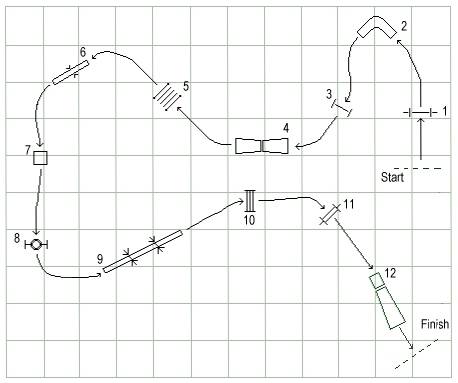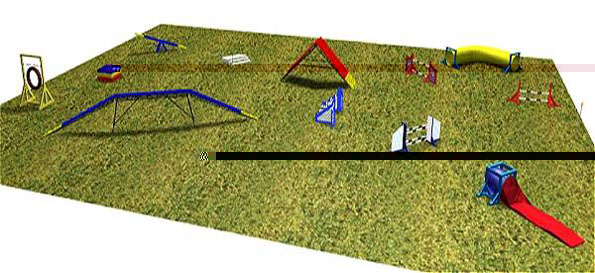| Standard - courses must include
jumps, all 3 contact obstacles, weave poles, the table, the flexible tunnel
and chute. The number of obstacles increases with the level of competition.
It demonstrates the overall ability of the dogs to perform all the obstacles.
Gamblers - the object of Gamblers is to successfully
complete as many obstacles as possible within a set time allowed in an
opening sequence. The obstacles each receive a different point value, common
values are jumps, 1 point, tire and tunnels are 2 points, contact 3 points,
weave 3 to 5 points. The opening sequence expires with blow of a whistle,
at which point the handler has a shorter set time to complete a closing
sequence. This final sequence or "gamble" must be done with the handler
remaining outside a prescribed area usually outlined with rope or tape
and within the time allowed. A required number of points are required,
in addition to the successful completion of the gamble within time for
a leg to be earned.
Gamblers: Requires a little bit of distance handling, but in Novice,
the distance obstacles will not include weaves or the teeter – usually
tunnels, jumps, and maybe the A-frame.
Jumpers - is composed of jumps, tires, tunnels,
and chutes. This game is probably the most popular event by many competitor
and spectators alike. It involves excellent handling skills and real team-work.
The pace is fast and furious with twisted flows and potential chances for
off course penalties at every turn. There is no reason not to enter
this class early on in your competitive career.
Team Relay (2,3 or 4 dogs) - designed to demonstrate
team spirit, strategy and sportsmanship. Relay involves a course layout
similar to standard agility. The course is divided in sections. All team
members must run clean and under the time allowed to earn a qualifying
leg. Failure to pass the baton in the specified area results in elimination.
This
is run as a relay – the first dog/handler run half of the course, pass
a baton to the second team, who finish the second half of the course. You
can enter with someone you know or get matched up by draw. At the Novice
level, everybody is in it for fun and nobody really cares if something
goes wrong in your half of the run, so don’t hesitate to enter.
Snooker - is base on the British game of Billiards.
There are two separate sequences. The opening sequence requires the handler
to perform one of 3 or 4 designated (red) jumps followed by an obstacle
of choice, and repeat this pattern at least twice more, a third time is
an option left to the judges discretion and outlined in the briefing. The
closing sequence requires the dog to follow the obstacles numbered 2 to
7. The game is based on points accumulated and as long as the dog has reached
or surpassed the required point level, a qualifying score will be earned.
One of the most complex games.
|

